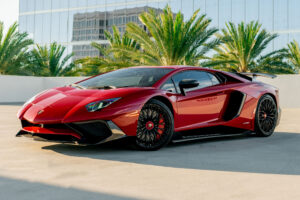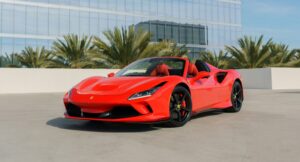Land Rover has established itself as an iconic brand in the automotive industry. It’s renowned for its robust vehicles that blend luxury with off-road capability effortlessly.
The origin of Land Rover traces back to 1948 when the Rover Company, then known for manufacturing luxury and touring cars, ventured into the creation of a practical 4WD vehicle. This initiative was led by Maurice Wilks, the company’s chief designer, who, inspired by the American Jeep, conceptualized the first Land Rover model. His initial design, famously drafted in the sand of a Welsh beach, laid the foundation for what would become a symbol of adventure and resilience.
Over the years, Land Rover has undergone significant transformations, reflecting advancements in technology and changes in consumer preferences. However, it has always maintained a core focus on the functionality and capability of its vehicles.
Starting with Series I, which debuted in 1948 as a strictly functional vehicle for farming and rugged terrain, Land Rover rapidly evolved to introduce improvements in comfort and performance.
The subsequent decades witnessed the brand’s model diversity and luxury offerings expansion, leading up to the Range Rover’s introduction in 1970—a vehicle that would come to epitomize the fusion of off-road prowess and premium refinement.
The history of Land Rover is not just about the vehicles themselves but also about innovation and adaptation. As the company entered the new millennium, it faced the challenge of integrating modern technology with traditional 4×4 capability.
As a result, Land Rover vehicles today are equipped with sophisticated electronics, luxurious interiors, and advanced safety features while retaining the brand’s legendary off-road functionality. This evolution reflects Land Rover’s commitment to excellence and its ability to remain relevant in an ever-changing automotive landscape.
Origins and Early Innovations
Land Rover’s journey began in 1948, when Maurice Wilks, the Chief Designer at the Rover Company, conceived it. Wilks was inspired by a wartime Jeep and envisioned a vehicle combining its off-road capability with innovation.
On a Welsh beach, Wilks famously sketched the silhouette of what would become the iconic Land Rover.
The first model, the Series I, was introduced at the Amsterdam Motor Show and was an instant success. Appealing for its simplicity and durability, this vehicle was not merely a car but a multi-purpose tool; it was lightweight yet robust, designed for demanding applications from agriculture to military.
| Innovation | Description |
| Body | They are made of a patented lightweight, rust-resistant aluminum-steel alloy. |
| Drivetrain | We are utilizing a four-wheel drive system derived from military technology. |
| Versatility | Configurable for various tasks, from farm work to exploration. |
The early technological advancements pioneered by the Land Rover centered on its adaptability. Influenced by the post-war scarcity of steel, they innovated with aluminum, which brought about the distinguished lightweight characteristic.
As a model, Series I encapsulated Maurice Wilks’ vision of a vehicle that could triumph over any terrain, laying the groundwork for a legacy of innovation and exploration, ensuring the marque’s sustainability and evolutionary path in the years to come.
Expansion and Evolution
Land Rover’s journey through the expansion and evolution of its brand in the latter part of the 20th century saw groundbreaking advancements in technology, design, and global market reach. Introducing new models solidified its reputation for luxury, performance, and all-terrain capability.
Developing the Range Rover Brand
The Range Rover brand, established in 1970, represented a revolutionary blend of luxury and capability. Emphasizing comfort and style, the Range Rover preserved the robust off-road performance Land Rover was known for.
Notable milestones include the 1981 introduction of the four-door model and the 1994 launch of the Second Generation Range Rover, which introduced significant technological enhancements like electronic traction control and air suspension systems.
Advancements in Technology and Design
Land Rover’s technological stride began with the Series II and Series IIA, offering improved performance over rough terrain.
By the 1980s and ’90s, a bold approach to vehicle design led to monocoque construction, enhancing structural integrity and ride quality.
The Discovery, launched in 1989, epitomized this shift with its family-friendly design without compromising off-road prowess.
| Decade | Technological Advancements |
| 1980s | Introduction of coil springs |
| The early 90s | Adoption of disc brakes |
| Mid 90s | Development of electronic systems |
The Growth of a Global Icon
Land Rover became a global icon during the last decades of the 20th century. In the 1990s, models like the Discovery and the Freelander catalyzed expansion into markets such as North America.
Ownership transitions from British Leyland to companies like BMW, Ford Motor Company, and eventually Tata Motors in the 21st century have further sustained its international footprint, culminating in contemporary legends like the Land Rover Defender.
Modern Era and the Move Towards Sustainability
The evolution of Land Rover in the modern era encapsulates a shift toward luxurious, high-performance SUVs alongside a dedication to incorporating green technology, all while reaching new heights in sustainability and innovation.
Introduction to Luxury and Performance SUVs
Land Rover has steadfastly expanded its lineup to offer an array of luxury SUVs that do not compromise on performance.
As staples in the Land Rover array, the Range Rover Evoque and Range Rover Sport exemplify adaptability and power merged seamlessly with upmarket sophistication.
The vehicles have been designed to cater to urban ease and comfort while maintaining the brand’s “Above and Beyond” off-road capability.
- Range Rover Evoque (2018): A compact luxury SUV combining style, agility, and forward-thinking technology.
- Range Rover Sport: A dynamic SUV known for its performance, luxury, and style, balancing on-road handling with off-road capability.
Incorporating Green Technology
Land Rover has embraced electric and hybrid technologies to address the urgent need for environmental sustainability.
Initiatives to embed sustainability into the brand’s DNA manifest in their pursuit of creating vehicles with a minimized carbon footprint.
Hybrid technology has been integrated into models such as the Land Rover Discovery and the Range Rover Evoque, offering a combination of internal combustion engines with electric motors to reduce emissions.
- Electric and Hybrid Models: Transitioning towards a greener future with electric (EV) and hybrid drivetrains investment.
- Sustainability Targets: Commitment to achieving net carbon zero by 2039 across the value chain.
Reaching New Heights in the 21st Century
Innovation has been the cornerstone of Land Rover’s approach to rewriting the rules of modern luxury vehicles in the 21st century.
Initiatives like the Open Innovation strategy and partnerships aim to accelerate next-generation technology.
These initiatives actively shape a sustainable and sophisticated vision for the future, keeping in line with the ‘Reimagine’ strategy.
Land Rover continues to push boundaries, ensuring that luxury, performance, and environmental responsibility are integrated.
- Innovative Partnerships: Collaborating with start-ups and external organizations to lead electrification, connectivity, and digital technologies.
- Modern Luxury Vision: Marrying the principles of luxury and sustainability in vehicle design and company ethos.

